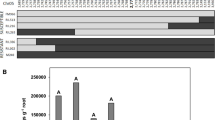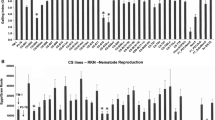Abstract
Key message
Transgene-based analysis of the MIC-3 gene provides the first report of a cotton gene having a direct role in mediating cotton resistance to root-knot nematode.
Abstract
Major quantitative trait loci have been mapped to Upland cotton (Gossypium hirsutum L.) chromosomes 11 and 14 that govern the highly resistant phenotype in response to infection by root-knot nematode (RKN; Meloidogyne incognita); however, nearly nothing is known regarding the underlying molecular determinants of this RKN-resistant phenotype. Multiple lines of circumstantial evidence have strongly suggested that the MIC (Meloidogyne Induced Cotton) gene family plays an integral role in mediating cotton resistance to RKN. In this report, we demonstrate that overexpression of MIC-3 in the RKN-susceptible genetic background Coker 312 reduces RKN egg production by ca. 60–75 % compared to non-transgenic controls and transgene-null sibling lines. MIC-3 transcript and protein overexpression were confirmed in root tissues of multiple independent transgenic lines with each line showing a similar level of increased resistance to RKN. In contrast to RKN fecundity, transgenic lines showed RKN-induced root galling similar to the susceptible controls. In addition, we determined that this effect of MIC-3 overexpression was specific to RKN as no effect was observed on reniform nematode (Rotylenchulus reniformis) reproduction. Transgenic lines did not show obvious alterations in growth, morphology, flowering, or fiber quality traits. Gene expression analyses showed that MIC-3 transcript levels in uninfected transgenic roots exceeded levels observed in RKN-infected roots of naturally resistant plants and that overexpression did not alter the regulation of native MIC genes in the genome. These results are the first report describing a direct role for a specific gene family in mediating cotton resistance to a plant-parasitic nematode.







Similar content being viewed by others
References
Andrade LBS, Oliveira AS, Ribeiro JKC, Kiyota S, Vasconcelos IM, Oliveira JTA, Sales MP (2010) Effects of a novel pathogenesis-related class 10 (PR-10) protein from Crotalaria pallida roots with papain inhibitory activity against root-knot nematode Meloidogyne incognita. J Agric Food Chem 58:4145–4152
Argout X et al (2011) The genome of Theobroma cacao. Nat Genet 43:101–108
Buriev ZT, Saha S, Abdurakhmonov IY, Jenkins JN, Abdukarimov A, Scheffler BE, Stelly DM (2010) Clustering, haplotype diversity and locations of MIC-3: a unique root-specific defense-related gene family in Upland cotton (Gossypium hirsutum L.). Theor Appl Genet 120:587–606
Callahan FE, Jenkins JN, Creech RG, Lawrence GW (1997) Changes in cotton root proteins correlated with resistance to root knot nematode development. J Cotton Sci 1:38–47
Callahan FE, Zhang X-D, Ma D-P, Jenkins JN, Hayes RW, Tucker ML (2004) Comparison of MIC-3 protein accumulation in response to root-knot nematode infection in cotton lines displaying a range of resistance levels. J Cotton Sci 8:186–190
Creech RG, Jenkins JN, Tang B, Lawrence GW, McCarty JC (1995) Cotton resistance to root-knot nematode: I. penetration and reproduction. Crop Sci 35:365–368
Ganji S, Wubben MJ, Jenkins JN (2013) Two simple methods for the collection of individual life stages of reniform nematode, Rotylenchulus reniformis. J Nematol 45:87–91
Gutierrez OA, Jenkins JN, McCarty JC, Wubben MJ, Hayes RW, Callahan FE (2010) SSR markers closely associated with genes for resistance to root-knot nematode on chromosomes 11 and 14 of Upland cotton. Theor Appl Genet 121:1323–1337
Hamamouch N, Li C, Seo PJ, Park C-M, Davis EL (2011) Expression of Arabidopsis pathogenesis-related genes during nematode infection. Mol Plant Pathol 12:355–364
He Y, Kumar P, Shen X, Davis RF, van Becelaere G, May OL, Nichols RL, Chee PW (2014) Re-evaluation of the inheritance for root-knot nematode resistance in the Upland cotton germplasm line M-120 RNR revealed two epistatic QTLs conferring resistance. Theor Appl Genet 127:1343–1351
Hood EE, Gelvin SB, Melchers LS, Hoekema A (1993) New Agrobacterium helper plasmids for gene transfer to plants. Trans Res 2:208–218
Hussey RS, Barker KR (1973) A comparison of methods of collecting inocula of Meloidogyne spp. Including a new technique. Plant Dis Rep 57:1025–1028
Jenkins JN, Creech RG, Tang B, Lawrence GW, McCarty JC (1995) Cotton resistance to root-knot nematode: II. post-penetration development. Crop Sci 35:369–373
Jenkins JN, McCarty JC, Wubben MJ, Hayes RW, Gutierrez OA, Callahan FE, Deng D (2012) SSR markers for marker assisted selection of root-knot nematode (Meloidogyne incognita) resistant plants in cotton (Gossypium hirsutum L.). Euphytica 183:49–54
Jones JT, Haegeman A, Danchin EGJ, Gaur HS, Helder J, Jones MGK, Kikuchi T, Manzanilla-Lopez R, Palomares-Rius JE, Wesemael WML, Perry RN (2013) Top 10 plant-parasitic nematodes in molecular plant pathology. Mol Plant Pathol 14:946–961
Koenning SR, Wrather JA, Kirkpatrick TL, Walker NR, Starr JL, Mueller JD (2004) Plant-parasitic nematodes attacking cotton in the United States. Plant Dis 88:100–113
Lawrence K, Olsen M, Faske T, Hutmacher R, Muller J, Mario J, Kemerait R, Overstreet C, Sciumbato G, Lawrence G, Atwell S, Thomas S, Koenning S, Boman R, Young H, Woodward J, Mehl H (2014) Cotton disease loss estimate committee report, 2013. In: Proceedings of the Beltwide Cotton Conference, New Orleans. National Cotton Council of America, Memphis, pp 247–248
Shen X, van Becelaere G, Kumar P, Davis RF, May OL, Chee P (2006) QTL mapping for resistance to root-knot nematodes in the M-120 RNR Upland cotton line (Gossypium hirsutum L.) of the Auburn 623 RNR source. Theor Appl Genet 113:1539–1549
Shepherd RL (1974) Transgressive segregation for root-knot nematode resistance in cotton. Crop Sci 14:872–875
Shepherd RL (1983) New sources of resistance to root-knot nematodes among primitive cottons. Crop Sci 23:999–1002
Shepherd RL, McCarty JC Jr, Jenkins JN, Parrott WL (1996) Registration of nine cotton germplasm lines resistant to root-knot nematode. Crop Sci 36:820
Walker-Peach C, Velten J (1984) Agrobacterium-mediated gene transfer to plant cells: cointegrate and binary vector systems. In:Gelvin SB, Schilperoort RA, Verma DPS (eds) Plant molecular biology manual. pp 1–19
Wan C-Y, Wilkins TA (1994) A modified hot borate method significantly enhances the yield of high quality RNA from cotton (Gossypium hirsutum L.). Anal Biochem 223:7–12
Williamson VM, Hussey RS (1996) Nematode pathogenesis and resistance in plants. Plant Cell 8:1735–1745
Wubben MJ, Callahan FE, Hayes RW, Jenkins JN (2008) Molecular characterization and temporal expression analyses indicate that the MIC (Meloidogyne Induced Cotton) gene family represents a novel group of root-specific defense-related genes in upland cotton (Gossypium hirsutum L.). Planta 228:111–123
Ynturi P, Jenkins JN, McCarty JC Jr, Gutierrez OA, Saha S (2006) Association of root-knot nematode resistance genes with simple sequence repeat markers on two chromosomes in cotton. Crop Sci 46:2670–2674
Zhang X-D, Callahan FE, Jenkins JN, Ma D-P, Karaca M, Saha S, Creech RG (2002) A novel root-specific gene, MIC-3, with increased expression in nematode-resistant cotton (Gossypium hirsutum L.) after root-knot nematode infection. Biochem Biophys Acta 1576:214–218
Zhang J, Waddell C, Sengupta-Gopalan C, Potenza C, Cantrell RG (2006) Relationships between root-knot nematode resistance and plant growth in Upland cotton: galling index as a criterion. Crop Sci 46:1581–1586
Acknowledgments
The authors would like to thank Dr. Russ Hayes (USDA-ARS) for his assistance in performing the statistical analyses of the nematode infection experiments. The authors also thank Drs. Patricia Timper and Jack McCarty Jr. (USDA-ARS) for their critical review of the manuscript and helpful comments.
Conflict of interest
The authors declare no conflict of interests.
Author information
Authors and Affiliations
Corresponding author
Additional information
Communicated by Brian Diers.
Mention of trade names or commercial products in this article is solely for the purpose of providing specific information and does not imply recommendation or endorsement by the United States Department of Agriculture.
Rights and permissions
About this article
Cite this article
Wubben, M.J., Callahan, F.E., Velten, J. et al. Overexpression of MIC-3 indicates a direct role for the MIC gene family in mediating Upland cotton (Gossypium hirsutum) resistance to root-knot nematode (Meloidogyne incognita). Theor Appl Genet 128, 199–209 (2015). https://doi.org/10.1007/s00122-014-2421-9
Received:
Accepted:
Published:
Issue Date:
DOI: https://doi.org/10.1007/s00122-014-2421-9




